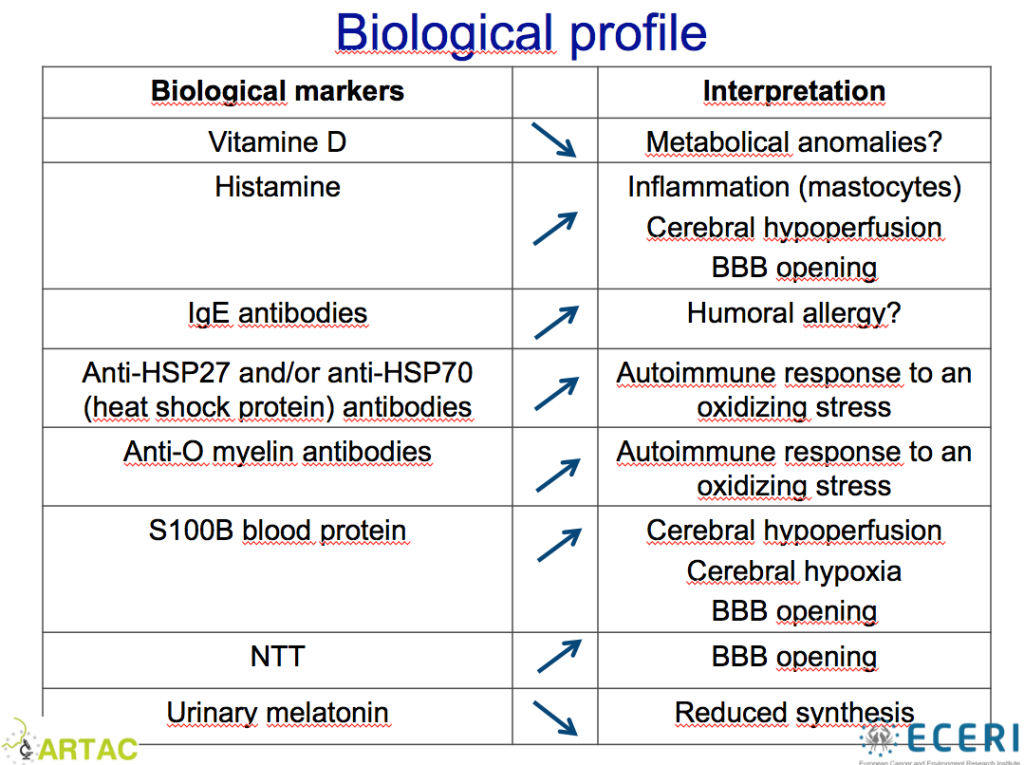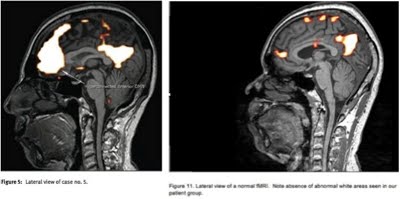
In the last few years, as EHS condition and EMF exposure, are becoming more common and more understood, we see more and more Studies supporting EHS as a health condition created and caused by exposure to EMF Radiation. These studies are mostly studies that search for biomarkers of EHS people compared with none EHS, studies that search for a pathological damage in EHS people, and also exposure studies in which the exposure sequences are planed to have the exact type of EMF that the subject is most sensitive to and the shame exposure is with no EMF exposure what so ever together with tracking the physiological characteristic of the subject (not just asking them to guess if there is radiation or not) and giving them enough time to recover between cycles. Other studies show improvement in the condition and symptoms after exposure is removed or reduces. Followed are several of these studies.
Evidence for a Novel Neurological Syndrome – Marino AA. 2011
Electromagnetic Hypersensitivity: Evidence for a Novel Neurological Syndrome – McCarty DE, Carrubba S, Chesson AL, Frilot C, Gonzalez-Toledo E, Marino AA. 2011 –https://maisonsaine.ca/wp-content/uploads/2015/05/172-IntJNeurosci2011.pdf
In this study, an EHS person was exposed to ELF(Extreme Low Frequency) EMR and showed severe symptoms The objective tests were done using EEG, MRI, Heartbeat measurement, blood test and other physical methods of sensing and did not rely on the subject observation or any subjective evaluation.
The full study – https://maisonsaine.ca/wp-content/uploads/2015/05/172-IntJNeurosci2011.pdf
Abstract – https://www.ncbi.nlm.nih.gov/pubmed/21793784
Professor Belpomme Study that shows that EHS is real and widespread
A leading team of scientists led by Professor Belpomme is investigating the EHS (since 2009) and should soon publish it’s final papers. The group has published in 2015 partial findings that show biomarkers for EHS and MCS(Multi Chemical Sensitivity).
Link – http://www.degruyter.com/view/j/reveh.2015.30.issue-4/reveh-2015-0027/reveh-2015-0027.xml?format=INT
In the following lecture (please see a link below) Professor Belpomme provided information about the tests done on 400 EHS people. The tests results show that EHS is real and not a Psychopathology problem.
More about this work: http://mieuxprevenir.blogspot.co.il/2012/06/electrosensitivity-es-ehs.html
Video presentation of Prof Belpomme – http://youtu.be/ONVFHQTuvD8

A study showing BioMarkers for EHS and MCS
“Metabolic and Genetic Screening of Electromagnetic Hypersensitive Subjects as a Feasible Tool for Diagnostics and Intervention”
Link – http://www.hindawi.com/journals/mi/2014/924184/
A study on the ways to improve EHS condition
This Finish study has analyzed the ways to handle and treat EHS condition and there effect. The study showed that reducing exposure was the most effective way to handle EHS and to reduce symptoms in most people. Other effective steps were nutritious changes, using food supplements and physical activity. Psychological and psychiatric treatment (this is how mainstream medicine try to treat EHS) was not effective and even worsen some of the EHS people condition
Link – http://www.ncbi.nlm.nih.gov/pubmed/23557856
A study on the causes, symptoms, effects, and way to handle EHS
In this Japanese study, they went and asked EHS people how their condition affects their lives, how they cope with there condition and what they believe was the reason the condition was caused by.
Symptoms:
86% chronic fatigue
81% headaches
other – memory problems, concentration issues.
Causes:
37% cell phone masts and wireless cordless phones,
65% use of cellphones by other people in trains and public transportation (12% said they can not use public transportation for that reason).
Life effect:
53% held a steady job before becoming EHS. Most of them lost it.
85% took steps to protect them self from EMF radiation, such as moving to a new home and/or buying low EMF equipment.
71% tried alternative medicine to ease the suffering.
Link – https://microondes.files.wordpress.com/2012/04/kato__johansson_2012-2.pdf
Pilot – Abnormal functional MRI brain scans in EHS people
Functional brain MRI in patients complaining of electrohypersensitivity after long term exposure to electromagnetic fields.
” All ten patients had abnormal functional MRI brain scans . The abnormality was often described as hyper connectivity of the anterior component of the default mode in the medial orbitofrontal area. Other abnormalities were usually found. Regular MRI studies of the brain were mostly unremarkable in these patients. “
DOI: 10.1515/reveh-2017-0014
Link – https://www.ncbi.nlm.nih.gov/pubmed/28678737

Does electromagnetic hypersensitivity originate from nocebo responses? Indications from a qualitative study.
This paper analyzes the science on EHS and determinates that the assumption that EHS is caused by Nocebo responses is wrong. The parer offers several steps to the development of EHS:
- Appearance of symptoms
- The person can’t find treatment or medication
- The person understands this might be sensitivity to EMF radiation
- The person started to read the collected information on EHS
- The person gradually and slowly understand he is an EHS person
- Trial and error searching for ways and treatments to ease the condition
- The person is 100% sure he is EHS.
The fact that in most case the symptoms appear before the person even know about EHS or EMF is in contrast with the “Nocebo responses” concept and denial that change of it being a psychosomatic response.
DOI: 10.1002/bem.21937
Link – https://www.ncbi.nlm.nih.gov/pubmed/26369906
Could myelin damage from radio frequency electromagnetic field exposure help explain the functional impairment electrohypersensitivity?
A scientific review of the possibility that damage to the myelin layer is one of the reasons and causes for EHS.
DOI: 10.1080/10937404.2014.923356
Link – https://www.ncbi.nlm.nih.gov/pubmed/25205214
EUROPAEM EMF Guideline 2016 for the prevention, diagnosis and treatment of EMF-related health problems and illnesses
This article is a summary of the work of more than 15 scientists that reviewed the science on EMF and EHS and suggested ways to prevent, diagnose and treat EHS.
DOI: 10.1515/reveh-2016-0011
Link – https://www.ncbi.nlm.nih.gov/pubmed/27454111
Guideline of the Austrian Medical Association for the diagnosis and treatment of EMF-related health problems and illnesses (EMFsyndrome)
A step by step guide for the diagnosis and treatment of EHS people and EMF related health problems. Written and published by the Austrian medical association in 2012.
Link – https://www.vagbrytaren.org/Guideline%20%20AG-EMF.pdf
Stephen J. Genuis a, Christopher T. Lipp -2011 summaries the background and scientific knowledge about EHS
The following report by Stephen J. Genuis a, Christopher T. Lipp -2011 summaries the background and scientific knowledge about EHS. The report is very good and can be used as a preview to EHS, and as a give away to medical stuff that is willing to consider the possibility that EHS is real.
Electromagnetic hypersensitivity: Fact or fiction? – Stephen J. Genuis a, Christopher T. Lipp -2011
https://doi.org/10.1016/j.scitotenv.2011.11.008
The microwave syndrome or electro-hypersensitivity: historical background.
History background about microwave sickness and EHS by Carpenter David in 2015.
DOI: 10.1515/reveh-2015-0016
Link – https://www.ncbi.nlm.nih.gov/pubmed/?term=26556835
Electromagnetic hypersensitivity–an increasing challenge to the medical profession.
History background of MW sickness and EHS review, alongside with case studies of several cases of EHS by Hedendahl L, Carlberg M, Hardell L. .” It seems necessary to give an International Classification of Diseases to EHS to get it accepted as EMF-related health problems. “.
DOI: 10.1515/reveh-2015-0012
Link – https://www.ncbi.nlm.nih.gov/pubmed/26372109
More studies:
More studies about EHS at http://www.es-uk.info/info/research.asp
More studies about EMF health effect at – https://www.norad4u.com/knowledge/studies
Prediction (2006) – 50% of the public will be EHS by 2017
The following article “Letter to the Editor: Will We All Become Electrosensitive?” by ÖRJAN HALLBERG AND GERD OBERFELD, that was published in 2006, bring some of the supporting scientific reports about EHS and summaries several other articles from different countries that estimated the number of EHS people in these countries. This article puts all the results of these estimations on a single graph and shows a constant growth in the percentage of EHS over the years and that in 2017, the percentage of EHS in the public will be ~50%.

32 leading scientists – EHS should be acknowledged as a Distinct Neuropathological Disorder – 07/2021
In this article , 32 leading scientist in the field of EMF health risk and EHS, are calling “for the acknowledgement of EHS as a distinct neuropathological disorder and for its inclusion in the WHO International Classification of Diseases“.
I addition they criticize the provocation studies as ” cannot presently be considered to be valid pathogenesis research methodologies“
Links:
https://www.mdpi.com/1422-0067/22/14/7321
Int. J. Mol. Sci. 2021, 22(14), 7321; https://doi.org/10.3390/ijms22147321
![Figure 1 EHS/MCS physiopathological model based on low-grade neuroinflammation and oxidative/nitrosative stress-induced blood–brain barrier disruption, according to Reference [9].](https://www.norad4u.com/wp-content/uploads/32Sci-800x556.png)
ELECTROMAGNETIC HYPERSENSITIVITY (EHS) IS A HUMANITARIAN CRISIS – ICBE-EMF
‘ELECTROMAGNETIC HYPERSENSITIVITY (EHS) IS A HUMANITARIAN CRISIS THAT REQUIRES AN URGENT RESPONSE’ – ICBE-EMF, July 2024 – https://icbe-emf.org/activities/electrohypersensitivity/
A special report of ICBE-EMF concludes that EHS is an urgent humanitarian crisis, affecting millions of people around the world. According to this report, the number of EHS people is increasing as general and personal exposure increases. Symptoms may appear after and because of the use of personal and home wireless/cellular equipment, or as exposure to radiation from infrastructure such as cell towers, smart meters, electric vehicles, power lines, and home appliances.
EHS is a multi-functional, multi-system reaction to EMF exposure, with symptoms that may vary from one person to the other. The reaction can be to very low levels of exposure, several magnitudes below the so-called “safe levels” (by ICNIRP or WHO). EHS affects 3%-5% of the public in the modern world. In many cases, the exposure is not voluntary and very hard to measure or reduce.
